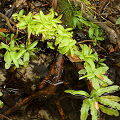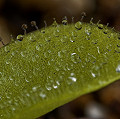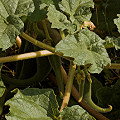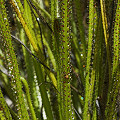Q: Exactly how do these plants capture prey? Answer #2--sticky traps
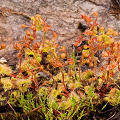 Drosera
Drosera
glanduligera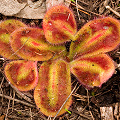 D. erythrorhiza
D. erythrorhiza
subsp. squamosa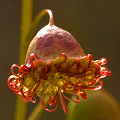 Drosera
Drosera
huegelii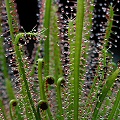 Drosera
Drosera
×hybrida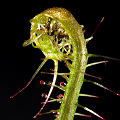 Drosera
Drosera
linearis
A: Many plants have sticky leaves. The source for the stickiness can be gumminess on the
surfaces of the leaves, or mucus produced on stalked glands. Usually the plants have evolved this stickiness to protect them
from invaders. For example, the next time you see tomato plants in a garden, look closely and you will probably find dead bugs
attached here and there to the leaves. It does not take much of a modification to transform this self defense system
to an offensive,
carnivorous system. The evolutionary pathway leading to sticky traps is easy to envision.
Examples of carnivorous plants with a primitive sticky traps are in the genus Byblis. These plants
have stalked glands that produce a gummy mucus. Bugs caught on the leaves are not digested by
plant enzymes. Instead, digestion is completed by symbiotic bugs. The resinous Roridula
plants operate much the same way. The majority of sticky trap plants produce digestive enzymes.
Sometimes, the plants exhibit leaf motions that bring digestive organs into contact with the prey--for example, the slime-bearing
tentacles of many Drosera bend towards the captured prey. Sometimes, even the entire leaf bends
over the prey, clasping it in an enzymatic embrace. Pinguicula leaves often roll up near the margins.
These motions do not help capture the prey--instead, they merely help speed digestion, presumably to improve the digestive
efficiency but also probably to help foil marauding kleptoparasites.
A few plants, such as D. glanduligera, D. burmannii, and
D. sessilifolia have much faster moving glands--especially on the leaf margins--and these glands
can carry or even catapult prey into the center of the leaf, where a forest of glandular hairs await.
A few sticky plants have brightly colored glands or boldly contrasting plant parts (such as
D. solaris). It may be that such coloration might help attract prey. Other plants have
odors---Drosophyllum lusitanicum has a honeylike scent, while some
Pinguicula and Byblis have a fungal odor.
Page citations: Lloyd, F.E. 1942; Rice, B.A. 2006a.
